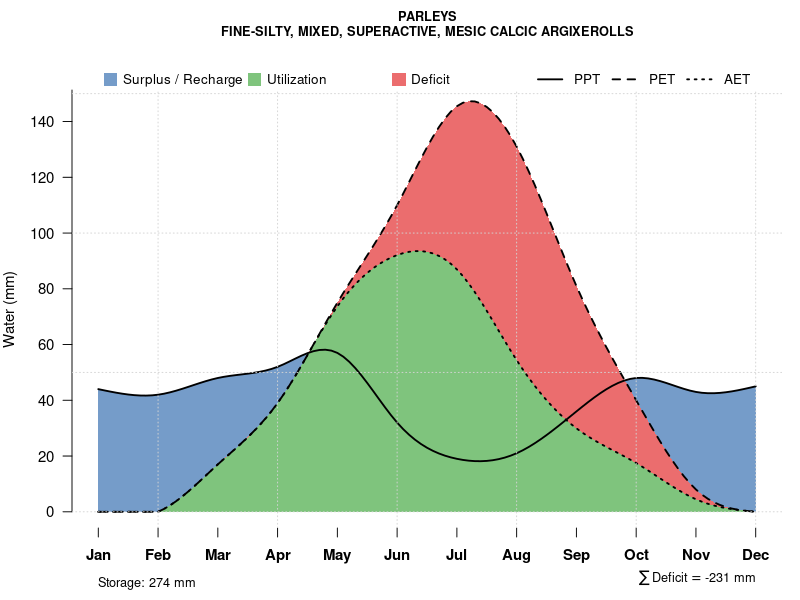| Parleys-Welby complex, 2 to 12 percent slopes | 86-O | 53 | 3163486 | 2yy4c | id713 | | 1:24000 |
Parleys silt loam, 0 to 4 percent slopes | 109 | 8718 | 485197 | j8wj | id714 | 1997 | 1:24000 |
Parleys silt loam, wet, 0 to 2 percent slopes | 111 | 2483 | 485200 | j8wm | id714 | 1997 | 1:24000 |
Trenton-Parleys, wet complex, 0 to 2 percent slopes | 142 | 653 | 485234 | j8xq | id714 | 1997 | 1:24000 |
Sterling-Parleys complex, 0 to 6 percent slopes | 137 | 306 | 485228 | j8xj | id714 | 1997 | 1:24000 |
Parleys silt loam, 4 to 8 percent slopes | 110 | 216 | 485199 | j8wl | id714 | 1997 | 1:24000 |
Parleys silt loam, 2 to 4 percent slopes | 85 | 7170 | 485683 | j9d6 | id715 | 1994 | 1:24000 |
Parleys silt loam, 0 to 2 percent slopes | 84 | 6877 | 485682 | j9d5 | id715 | 1994 | 1:24000 |
Parleys-Wheelon complex, 4 to 12 percent slopes | 87 | 4931 | 485685 | j9d8 | id715 | 1994 | 1:24000 |
Parleys-Welby complex, 2 to 12 percent slopes | 86 | 4643 | 3163601 | 2yy4c | id715 | 1994 | 1:24000 |
Welby-Parleys complex, 0 to 2 percent slopes | 131 | 1697 | 485601 | j99k | id715 | 1994 | 1:24000 |
Parleys silt loam, 1 to 6 percent slopes | PeB | 17046 | 481443 | j4zf | ut602 | 1969 | 1:20000 |
Parleys silt loam, 6 to 10 percent slopes | PeD | 6686 | 481444 | j4zg | ut602 | 1969 | 1:20000 |
Parleys loam, cool, 0 to 3 percent slopes | PdA | 4652 | 481441 | j4zc | ut602 | 1969 | 1:20000 |
Parleys-Munk complex, 10 to 20 percent slopes | PmE | 3788 | 481448 | j4zl | ut602 | 1969 | 1:20000 |
Parleys-Pomat silt loams, 6 to 10 percent slopes | PnD | 3720 | 481449 | j4zm | ut602 | 1969 | 1:20000 |
Sterling-Parleys complex, 6 to 20 percent slopes | SuE | 3672 | 481495 | j513 | ut602 | 1969 | 1:20000 |
Pomat-Parleys silt loams, 10 to 30 percent slopes | PyE | 2872 | 481456 | j4zv | ut602 | 1969 | 1:20000 |
Parleys loam, 0 to 3 percent slopes | PbA | 2293 | 481440 | j4zb | ut602 | 1969 | 1:20000 |
Parleys silt loam, 10 to 20 percent slopes | PeE | 1536 | 481445 | j4zh | ut602 | 1969 | 1:20000 |
Parleys silt loam, 0 to 1 percent slopes | PeA | 1011 | 481442 | j4zd | ut602 | 1969 | 1:20000 |
Parleys-Munk complex, 6 to 10 percent slopes | PmD | 860 | 481447 | j4zk | ut602 | 1969 | 1:20000 |
Parleys silty clay loam, 0 to 3 percent slopes | PlA | 290 | 481446 | j4zj | ut602 | 1969 | 1:20000 |
PARLEYS SILT LOAM, 0 TO 3 PERCENT SLOPES | PaA | 1423 | 482797 | j6d3 | ut603 | 1968 | 1:20000 |
PARLEYS SILT LOAM, 3 TO 6 PERCENT SLOPES | PaB | 951 | 482798 | j6d4 | ut603 | 1968 | 1:20000 |
PARLEYS SILT LOAM, 6 TO 10 PERCENT SLOPES | PaC | 469 | 482799 | j6d5 | ut603 | 1968 | 1:20000 |
Parleys loam, 0 to 4 percent slopes | 1000 | 10062 | 481624 | 2tjtg | ut607 | 1965 | 1:15840 |
Parleys loam, 3 to 8 percent slopes | 8012 | 1834 | 481626 | 2tjsx | ut607 | 1965 | 1:15840 |
Hillfield-Timpanogos-Parleys complex, 30 to 60 percent slopes, eroded | HTG2 | 1706 | 481568 | j53g | ut607 | 1965 | 1:15840 |
Parleys loam, 6 to 10 percent slopes | PaD | 982 | 481627 | j55c | ut607 | 1965 | 1:15840 |
Hillfield-Timpanogos-Parleys complex, 20 to 30 percent slopes, eroded | HTF2 | 658 | 481567 | j53f | ut607 | 1965 | 1:15840 |
Parleys loam, 10 to 20 percent slopes, eroded | PaE2 | 625 | 481628 | j55d | ut607 | 1965 | 1:15840 |
Parleys loam, 3 to 8 percent slopes | 8012 | 1993 | 2981375 | 2tjsx | ut608 | 1981 | 1:24000 |
Parleys loam, 5 to 15 percent slopes | 8013 | 790 | 2981376 | 2tjsy | ut608 | 1981 | 1:24000 |
Parleys loam, high rainfall, 0 to 3 percent slopes | PaA | 1740 | 506607 | k055 | ut609 | 1974 | 1:24000 |
Parleys silt loam, 0 to 3 percent slopes | PeA | 7317 | 482958 | j6k9 | ut612 | 1967 | 1:20000 |
Parleys loam, 0 to 4 percent slopes | 1000 | 1977 | 482957 | 2tjtg | ut612 | 1967 | 1:20000 |
Parleys silt loam, 3 to 6 percent slopes | PeB | 960 | 482959 | j6kb | ut612 | 1967 | 1:20000 |
Parleys loam, 0 to 4 percent slopes | 1000 | 3070 | 483348 | 2tjtg | ut621 | 1966 | 1:20000 |
Parleys silty clay loam, 0 to 3 percent slopes | PcB | 1878 | 483351 | j6yz | ut621 | 1966 | 1:20000 |
Parleys loam, 3 to 8 percent slopes | 8012 | 1363 | 483349 | 2tjsx | ut621 | 1966 | 1:20000 |
Parleys gravelly loam, overwashed, 3 to 6 percent slopes | PbC | 220 | 483350 | j6yy | ut621 | 1966 | 1:20000 |
Parleys loam, 5 to 15 percent slopes | 8013 | 161 | 2981399 | 2tjsy | ut621 | 1966 | 1:20000 |
PARLEYS SILT LOAM, 6 TO 10 PERCENT SLOPES | PaC | 11 | 3450363 | j6d5 | ut647 | | 1:24000 |














